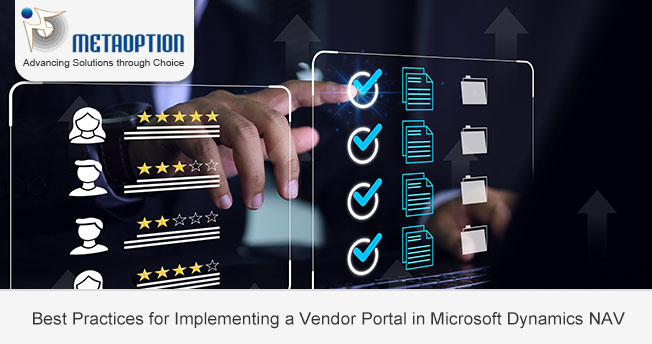In today’s fast-paced business environment, efficiency and collaboration are key to success. For companies using Microsoft Dynamics NAV (formerly Navision) as their Enterprise Resource Planning (ERP) solution, implementing a vendor portal can be a game-changer. A vendor portal streamlines communication, simplifies processes and fosters stronger vendor relationships. However, implementing one successfully requires careful planning and adherence to best practices. In this blog, we’ll explore the essential best practices for implementing a vendor portal in Microsoft Dynamics NAV.

Practices for implementing a vendor portal in Microsoft Dynamics NAV
-
Define Your Objectives
Before you start the implementation process, it’s crucial to define your objectives. What specific problems or challenges are you aiming to address with the vendor portal? Whether it’s reducing procurement lead times, improving order accuracy, or enhancing collaboration with vendors, a clear understanding of your goals will guide the entire project.
-
Choose the Right Vendor Portal Solution
Selecting the right vendor portal solution is paramount. Ensure it seamlessly integrates with Microsoft Dynamics NAV, offering the features and functionalities that align with your objectives. Look for a user-friendly, secure, and scalable solution to meet your evolving business needs.
-
Involve Key Stakeholders
Effective communication and collaboration are key to a successful implementation. Involve all key stakeholders, including procurement teams, IT, vendors, and end-users, from the outset. Their input and feedback will be invaluable during the design and implementation phases.
-
Customize and Configure
Tailor the vendor portal to your specific business processes. Customize the portal to match your branding, and configure it to automate tasks and workflows. The goal is to create a solution that seamlessly integrates into your existing operations.
-
Ensure Data Accuracy
Data accuracy is critical for the success of your vendor portal. Ensure that the data within Microsoft Dynamics NAV is up-to-date and accurate. Inaccurate data can lead to errors and delays in procurement and other processes.
-
Prioritize User Training
Comprehensive user training is essential. Ensure that all employees and vendors who will use the portal are well-trained. This will not only increase adoption but also reduce the likelihood of errors and support requests.
-
Monitor and Evaluate
Post-implementation, continue to monitor and evaluate the vendor portal’s performance. Track key performance indicators (KPIs) to ensure it’s meeting your objectives. Be prepared to make adjustments and improvements as needed.
-
Focus on Security
Security is a top priority when implementing a vendor portal. Protect sensitive data and ensure secure access to the portal. Implement strong authentication methods and encryption to safeguard your information.
-
Foster Vendor Collaboration
A successful vendor portal encourages collaboration with your suppliers. Maintain open lines of communication with your vendors and seek their feedback on the portal’s usability and functionality. This can lead to further improvements and a stronger, more collaborative relationship.
-
Plan for Scalability
Your business will evolve, and your vendor portal should be able to adapt. Plan for scalability from the outset so that your portal can grow with your business and accommodate increased data and user requirements.
Winding Up
Implementing a vendor portal in Microsoft Dynamics NAV can revolutionize the way you manage vendor relationships and streamline your procurement processes. By following these best practices, you can increase the likelihood of a successful implementation and enjoy the benefits of improved efficiency and collaboration within your supply chain. Remember that technology is just one part of the equation; the people and processes behind it are equally important.
For more information and a tailored demonstration contact us today at Metaoption.


